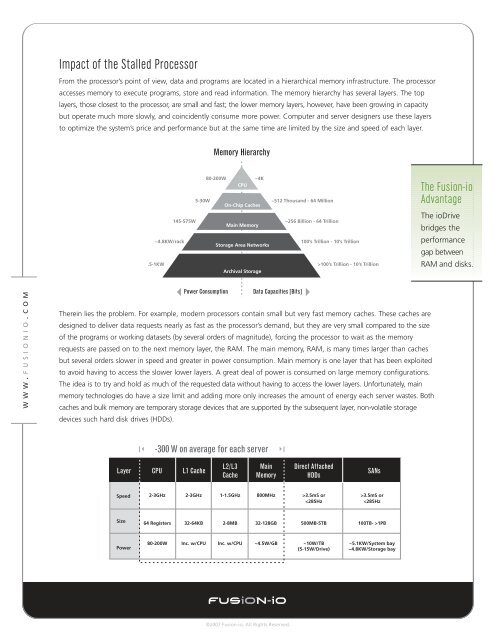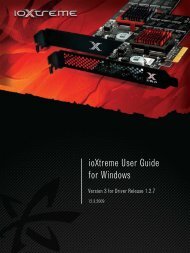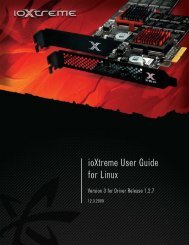Taming the Power Hungry Data Center - Fusion-io
Taming the Power Hungry Data Center - Fusion-io
Taming the Power Hungry Data Center - Fusion-io
Create successful ePaper yourself
Turn your PDF publications into a flip-book with our unique Google optimized e-Paper software.
Impact of <strong>the</strong> Stalled Processor<br />
From <strong>the</strong> processor’s point of view, data and programs are located in a hierarchical memory infrastructure. The processor<br />
accesses memory to execute programs, store and read informat<strong>io</strong>n. The memory hierarchy has several layers. The top<br />
layers, those closest to <strong>the</strong> processor, are small and fast; <strong>the</strong> lower memory layers, however, have been growing in capacity<br />
but operate much more slowly, and coincidently consume more power. Computer and server designers use <strong>the</strong>se layers<br />
to optimize <strong>the</strong> system’s price and performance but at <strong>the</strong> same time are limited by <strong>the</strong> size and speed of each layer.<br />
Memory Hierarchy<br />
5-30W<br />
145-575W<br />
~4.8KW/rack<br />
.5-1KW<br />
80-200W<br />
~4K<br />
CPU<br />
~512 Thousand - 64 Mill<strong>io</strong>n<br />
On-Chip Caches<br />
~256 Bill<strong>io</strong>n - 64 Trill<strong>io</strong>n<br />
Main Memory<br />
100’s Trill<strong>io</strong>n - 10’s Trill<strong>io</strong>n<br />
Storage Area Networks<br />
>100’s Trill<strong>io</strong>n - 10’s Trill<strong>io</strong>n<br />
Archival Storage<br />
The <strong>Fus<strong>io</strong>n</strong>-<strong>io</strong><br />
Advantage<br />
The <strong>io</strong>Drive<br />
bridges <strong>the</strong><br />
performance<br />
gap between<br />
RAM and disks.<br />
WWW. FUSIONIO. COM<br />
<strong>Power</strong> Consumpt<strong>io</strong>n <strong>Data</strong> Capacities [Bits]<br />
Therein lies <strong>the</strong> problem. For example, modern processors contain small but very fast memory caches. These caches are<br />
designed to deliver data requests nearly as fast as <strong>the</strong> processor’s demand, but <strong>the</strong>y are very small compared to <strong>the</strong> size<br />
of <strong>the</strong> programs or working datasets (by several orders of magnitude), forcing <strong>the</strong> processor to wait as <strong>the</strong> memory<br />
requests are passed on to <strong>the</strong> next memory layer, <strong>the</strong> RAM. The main memory, RAM, is many times larger than caches<br />
but several orders slower in speed and greater in power consumpt<strong>io</strong>n. Main memory is one layer that has been exploited<br />
to avoid having to access <strong>the</strong> slower lower layers. A great deal of power is consumed on large memory configurat<strong>io</strong>ns.<br />
The idea is to try and hold as much of <strong>the</strong> requested data without having to access <strong>the</strong> lower layers. Unfortunately, main<br />
memory technologies do have a size limit and adding more only increases <strong>the</strong> amount of energy each server wastes. Both<br />
caches and bulk memory are temporary storage devices that are supported by <strong>the</strong> subsequent layer, non-volatile storage<br />
devices such hard disk drives (HDDs).<br />
-300 W on average for each server<br />
Layer CPU L1 Cache<br />
L2/L3<br />
Cache<br />
Main<br />
Memory<br />
Direct Attached<br />
HDDs<br />
SANs<br />
Speed 2-3GHz 2-3GHz 1-1.5GHz 800MHz >3.5mS or >3.5mS or<br />















